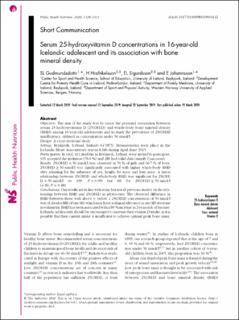| dc.contributor.author | Guðmundsdóttir, Sigríður Lára | |
| dc.contributor.author | Hrafnkelsson, Hannes | |
| dc.contributor.author | Sigurðsson, Emil Lárus | |
| dc.contributor.author | Johannsson, Erlingur | |
| dc.date.accessioned | 2020-09-02T11:00:57Z | |
| dc.date.available | 2020-09-02T11:00:57Z | |
| dc.date.created | 2020-07-29T12:38:44Z | |
| dc.date.issued | 2020 | |
| dc.identifier.citation | Gudmundsdottir, S. L., Hrafnkelsson, H., Sigurdsson, E. L., & Johannsson, E. (2020). Serum 25-hydroxyvitamin D concentrations in 16-year-old Icelandic adolescent and its association with bone mineral density. Public Health Nutrition, 23(8), 1329-1333. | en_US |
| dc.identifier.issn | 1368-9800 | |
| dc.identifier.uri | https://hdl.handle.net/11250/2676002 | |
| dc.description.abstract | Objective:
The aim of the study was to assess the potential association between serum 25-hydroxyvitamin D (25(OH)D) and whole-body bone mineral density (BMD) among 16-year-old adolescents and to study the prevalence of 25(OH)D insufficiency, defined as concentration under 50 nmol/l.
Design:
A cross-sectional study.
Setting:
Reykjavik, Iceland, latitude 64°08′N. Measurements took place in the Icelandic Heart Association's research lab during April–June 2015.
Participants:
In total, 411 students in Reykjavik, Iceland, were invited to participate, 315 accepted the invitation (76·6 %) and 289 had valid data (mainly Caucasian).
Results:
25(OH)D < 50 nmol/l was observed in 70 % of girls and 66·7 % of boys. 25(OH)D ≥ 50 nmol/l was significantly associated with higher whole-body BMD after adjusting for the influence of sex, height, fat mass and lean mass. A linear relationship between 25(OH)D and whole-body BMD was significant for 25(OH)D < 50 nmol/l (n 199, P < 0·05) but NS for 25(OH)D ≥ 50 nmol/l (n 86, P = 0·48).
Conclusions:
Our results are in line with some but not all previous studies on the relationship between BMD and 25(OH)D in adolescents. The observed difference in BMD between those with above v. below a 25(OH)D concentration of 50 nmol/l was of about a fifth of one SD, which may have a clinical relevance as one SD decrease in volumetric BMD has been associated with a 89 % increase in 2 years risk of fracture. Icelandic adolescents should be encouraged to increase their vitamin D intake as it is possible that their current intake is insufficient to achieve optimal peak bone mass. | en_US |
| dc.language.iso | eng | en_US |
| dc.rights | Navngivelse 4.0 Internasjonal | * |
| dc.rights.uri | http://creativecommons.org/licenses/by/4.0/deed.no | * |
| dc.subject | 25-hydroxyvitamin D | en_US |
| dc.subject | Bone mineral density | en_US |
| dc.subject | Adolescent | en_US |
| dc.subject | Cross sectional | en_US |
| dc.subject | Vitamin D | en_US |
| dc.title | Serum 25-hydroxyvitamin D concentrations in 16-year-old Icelandic adolescent and its association with bone mineral density | en_US |
| dc.type | Peer reviewed | en_US |
| dc.type | Journal article | en_US |
| dc.description.version | publishedVersion | en_US |
| dc.rights.holder | © The Author(s) | en_US |
| dc.source.pagenumber | 1329-1333 | en_US |
| dc.source.volume | 23 | en_US |
| dc.source.journal | Public Health Nutrition | en_US |
| dc.source.issue | 8 | en_US |
| dc.identifier.doi | 10.1017/S1368980019004142 | |
| dc.identifier.cristin | 1820880 | |
| cristin.ispublished | true | |
| cristin.fulltext | original | |
| cristin.qualitycode | 1 | |

